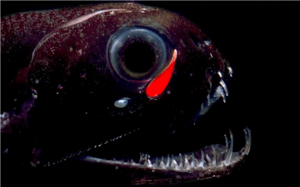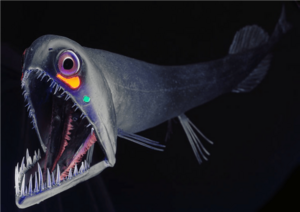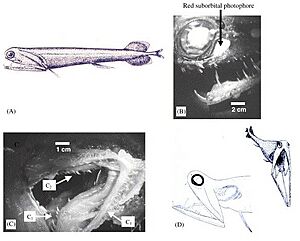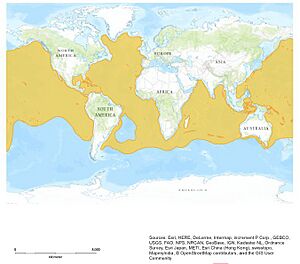Black dragon fish facts for kids
Quick facts for kids Black dragon fish |
|
|---|---|
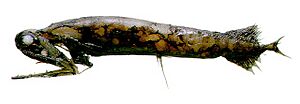 |
|
| Conservation status | |
| Scientific classification | |
| Synonyms | |
The black dragonfish (scientific name: Malacosteus niger) is a fascinating deep-sea fish. It's also known by other cool names like northern stoplight loosejaw or black loosejaw. This fish belongs to a family called Stomiidae, which are often called dragonfishes.
The black dragonfish is one of the top hunters in the open mesopelagic zone. This is a deep part of the ocean where sunlight barely reaches. M. niger lives all over the world, from tropical areas to colder subarctic waters.
One amazing thing about this fish is its ability to make its own light, called bioluminescence. It can produce both blue and red light! Most deep-sea creatures can only make blue light. This red light gives the black dragonfish a special advantage. Most other sea creatures can't see red light. This means the dragonfish can hide from its prey and predators, or even use its red light like a secret flashlight to find food without being seen.

Contents
How the Black Dragonfish Sees and Looks
Amazing Eyesight in the Deep
The black dragonfish has special yellow lenses in its eyes. Scientists believe these lenses help the fish see its own red bioluminescence better. Its eyes are made up entirely of "rods," which are cells that help with vision in dim light. Unlike many other deep-sea fish, the black dragonfish can see red light. This is a huge advantage in the dark ocean depths.
The yellow lenses also help by blocking out blue light. This makes the fish even more sensitive to the longer, red wavelengths of light. This is perfect for using its red bioluminescence.
Unique Body Features
The black dragonfish has one of the biggest mouths compared to its body size! Its lower jaw is about a quarter of its total length (like in Figure A). It also has large, curved fangs that point backward into its mouth. These fangs make it very hard for prey to escape once caught (Figure B).
Unlike many meat-eating fish, M. niger doesn't have gill rakers or gill teeth (Figure C). Its front backbone bones are not fully hardened. This allows the fish to "throw back its head" to swallow really big prey. Also, the black dragonfish has no "floor" in its mouth (Figure D). This unique feature lets it open its mouth super wide. It can quickly close its mouth on fast-swimming prey with less effort. This saves energy and helps it catch food.
The black dragonfish can grow up to about 25.6 centimeters (10.1 inches) long. Its scientific name, niger, is Latin for "black," which perfectly describes its color.
Where They Live and What They Eat
Home in the Ocean Depths
The black dragonfish lives all around the world. You can find it from the Arctic in the north to the Southern Hemisphere. While it's found globally, it seems to be quite common in the Eastern Central Atlantic Ocean.
M. niger stays in the mesopelagic zone, which is a deep part of the ocean. It usually lives between 500 meters (about 1,640 feet) and 1,000 meters (about 3,280 feet) deep. Interestingly, it's thought to be the only fish in its family that doesn't migrate up to the surface at night. Most other deep-sea fish swim up to shallower waters to feed.
What's on the Menu?
You might think that with its huge fangs and giant mouth, the black dragonfish would eat only large fish. But surprisingly, a big part of its diet is tiny zooplankton! It mainly eats small crustaceans called calanoid copepods. It also eats small shrimp and other tiny sea creatures.
The black dragonfish digests its food very quickly. This means it has to keep eating these small prey items constantly to have enough energy. Studies show that copepods make up about 69% to 83% of its diet. This suggests that finding large prey in the deep ocean is quite rare.
Scientists think the black dragonfish uses its special red bioluminescence to find these tiny zooplankton. It lights up a small area, like a secret searchlight, to spot its small meals. The pigment needed for its red light detection likely comes from the copepods themselves, which contain chlorophyll from eating plants.
The Mystery of Red Bioluminescence
The black dragonfish's ability to make red bioluminescence is very rare. Only two other deep-sea creatures, Aristostomias and Pachystomias, can do this. This special red light can reach wavelengths up to 700 nanometers. This is important because most other deep-sea creatures only see blue or green light. This gives the black dragonfish a huge advantage when hunting. It can see its prey, but its prey can't see it!
The black dragonfish has a special tear-drop shaped light organ called a suborbital photophore. This organ is dark brown and emits red light. This red light is created when chemicals inside the photophore react and transfer energy to a red-glowing material.
The fish can control this red light organ separately from its blue light organ. The red light can even stay on for longer periods. This amazing adaptation helps the black dragonfish survive and thrive in the dark, mysterious world of the deep sea.



